Siding
Siding
California Code Requirements
Since January 2008 new construction in wildfire prone areas of the state have had to comply to certain requirements. These requirement are found in Chapter 7A of the California Building Code. Chapter 7A provides the regulations for 'Materials and Construction Methods for Exterior Wildfire Exposure'. This section will discuss Chapter 7A code requirements for siding.
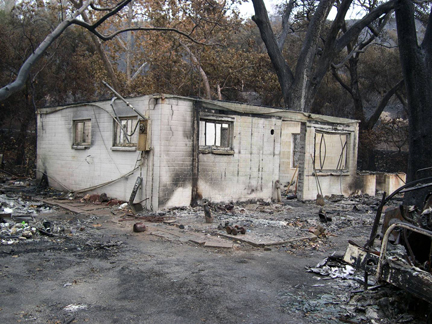
There are three ways for exterior siding to comply with Chapter 7A. Any one of the methods can be to comply.
- The first relies on code-based definitions of 'noncombustible' and 'ignition resistant'. If a material relies on an added treatment to provide a flame spread rating low enough to comply with the definition of 'ignition resistant', then that material must undergo the accelerated weathering procedure outlined in UBC Standard 23-4 [the same procedure as in ASTM Standard D-2898].
- The second option is a prescriptive one. If the siding is made from timbers that are large enough to comply with the definition 'heavy timber', then that siding complies. Similarly, round logs used in a log home also comply prescriptively.
- The third way to comply is to pass the Office of the State Fire Marshal Standard SFM 12-7A-1 for Exterior Wall Siding and Sheathing. This is the method used for other combustible siding products (for example, untreated wood lap and panelized siding, vinyl or other plastic or wood-plastic composite product.) The SFM wall test evaluates the ability of the siding product (and assembly) to resist the penetration of a flame into the stud cavity. It doesn't consider vertical flame spread on the wall.
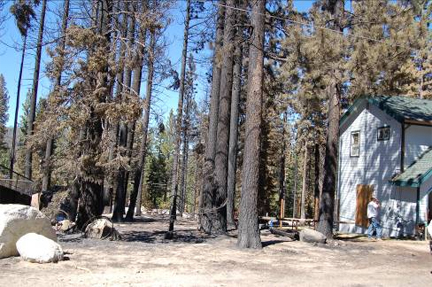
The apparatus shown in this photograph is used to evaluate the flame spread rating for a material. It is also used in the test to evaluate if a material meets the requirements to be called an ignition resistant material. The standard test method is described in ASTM E-84.
Requirements for an ignition resistant material:
- flame spread < 25, 30 minute period
- flame front progress < 10 '' beyond centerline of burner
- exterior-type designation based on UBC 23-4 (ASTM D-2898) accelerated weathering exposure
For siding applications, the most common example of an ignition resistant material is exterior rated, fire-retardant treated wood. The fire retardant is applied by a pressure impregnation process.
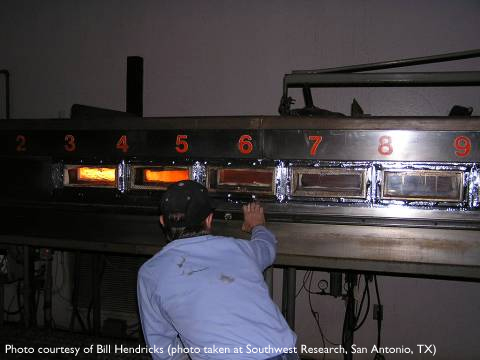
Packaged shingles, prior to being put in treatment cylinder for fire-retardant pressure impregnation treatment.
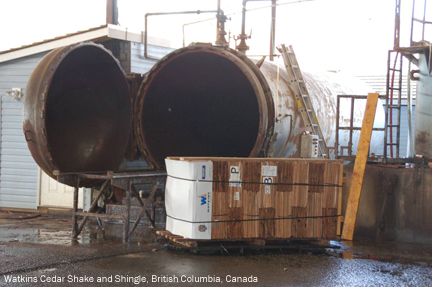
Products that will comply as noncombustible include fiber cement siding products (lap or panel), metal siding, and traditional three-coat stucco.
ASTM E-136 is a standard test that can be used to determine if a given material can be classified as 'noncombustible'. For example, wood fiber is used in fiber cement siding products. ASTM E-136 was used to confirm that, even with the fiber component, the fiber cement product could still be classified as noncombustible. Other composite materials and assemblies that have noncombustible 'skins' (for example, an exterior insulation finishing system, EIFS siding) and aren't specifically defined as 'noncombustible' in the building code will have to show compliance via one of the approved tests.
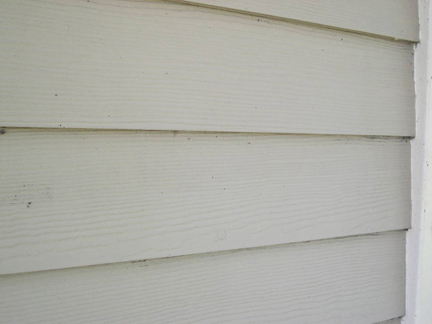
Log wall siding complies prescriptively.
The char rate of logs in a log wall was determined to be ~1.5 in/hr. From a penetration perspective, the vulnerable location won't be the log, but it could be the between log
joints. The caulking ('chinking') needs to provide similar protection from the fire.
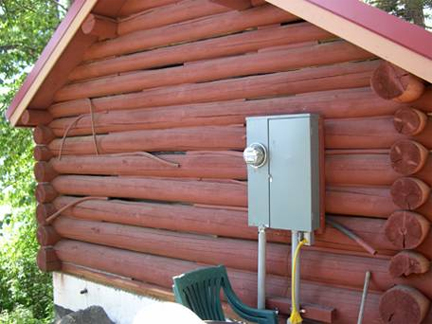
There are two concerns regarding the performance of exterior siding.
- Ignition and flame penetration through the wall and into the stud cavity, and
- Ignition and flame spread up the wall to the soffit / eave area, potentially entering the attic and igniting combustibles there.
Similarly, flame spread up the wall, with impingement on the window, with glass breakage and fire entry into the occupied space of the building.
These photos are from a fire demonstration, and is intended to show these two factors. The photo on the right shows a corner section. The flaming wall was made with a composite siding product. The other wall (not burning) was made with a fiber cement siding product.
The fire test for combustible siding (SFM 12-7A-1) evaluates how readily flame will penetrate into the lap joint and move into the stud cavity. It doesn't address flame spread per se.
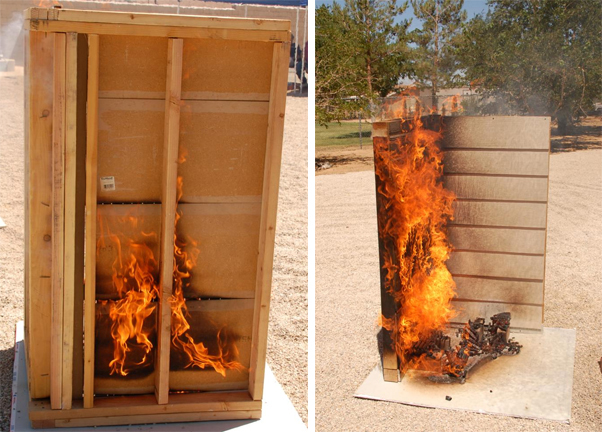
Combustible siding products have to comply to Chapter 7A by meeting one of the requirements outlined in the siding section. Plain bevel lap joints are vulnerable to flame penetration at the joint. The plane bevel joint shown in the left-hand diagram failed in about 1:15 min, so wouldn't comply with the provisions of Chapter 7A.
A more complicated lap joint (i.e., shiplap and tongue and groove) will provide more resistance to the penetration of fire when subjected to a flame impingement exposure. Fire penetrated the shiplap joint, shown in the right-hand diagram, in about 21 ' min.
The vulnerability of the plane bevel lap joint in combustible siding (wood, other wood-based composite products) doesn't apply to the commonly used plane bevel joint used in the noncombustible fiber-cement siding products. These joints perform well.
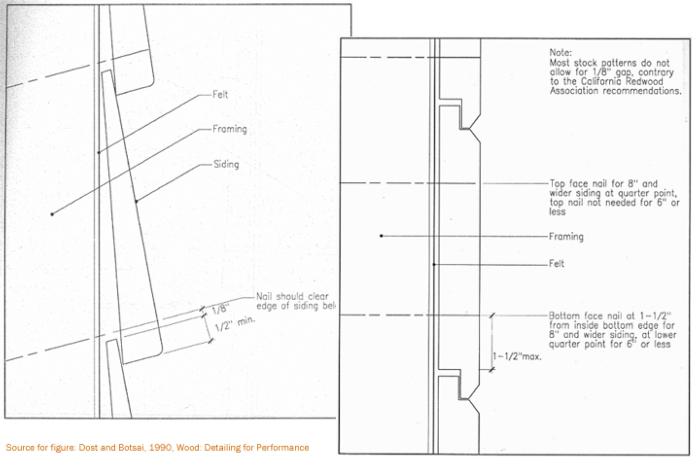
Untreated combustible siding products (i.e., those that cannot comply as 'ignition resistant') will have to be tested and comply with the penetration resistant requirements of SFM 12-7A-1. In this photograph, fire has penetrated through the lap joint and into the stud cavity. As constructed, this product does not comply, but SFM 12-7A-1 allows the use of sheathing to comply. Products with a more complicated lap joint (vertical or horizontal), will be more likely to pass. Horizontal lap wood siding products usually comply by using sheathing (plywood or oriented strand board) in the assembly.
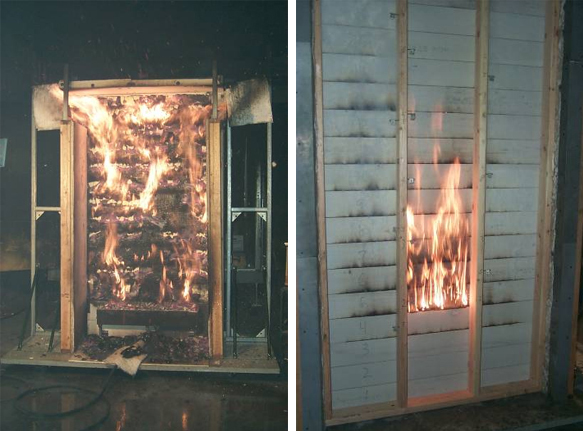
Vinyl siding won't sustain combustion once the other combustible materials have been consumed. Performance of vinyl clad exterior walls will largely depend on the performance of the underlying sheathing (if present).
In this case the (radiant) fire exposure was from a neighbor's home, approximately 50-ft away, that ignited and burned to the ground.
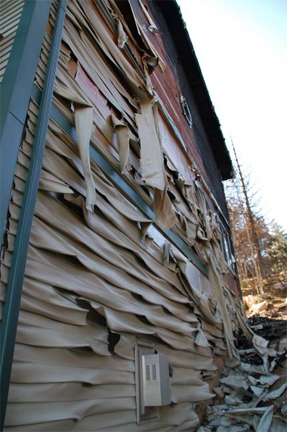
Specific requirements for corner trim are not included in Chapter 7A.SFM 12-7A-1 uses a flat wall apparatus and therefore incorporating a combustible trim product in this test isn't possible.
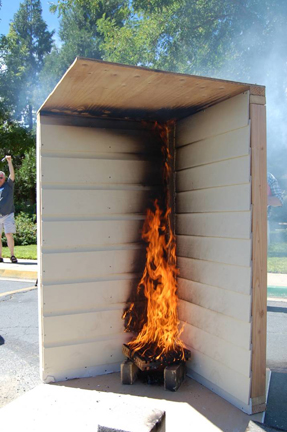
The vertical furnace shown in this photograph is used to evaluate the fire performance of wall assemblies (for example, a 1-hour wall), as specified in ASTM E-119. The fire exposure provided in this test is very severe, but isn't currently used in Chapter 7A to evaluate siding. However, the California Building Standards Commission is currently considering allowing a 'one-hour' wall to comply with Chapter 7A requirements.
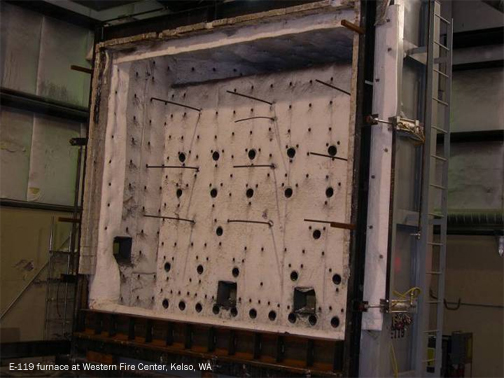
To determine is a given siding product complies with Chapter 7A:
- Product is included in 'WUI Product Handbook'
- Product is included in a '7A compliant materials attachment' to an existing ICC-ES Report [so far ICC is limiting procedure to siding and decking]
The OSFM Building Materials Listing program is voluntary, but it is used by many manufacturers that have products complying with Chapter 7A. Products that comply are listed, by component, on the OSFM website.
The listing is based on an evaluation of test results that include an analysis of required product performance and reliability features. Listed products have been tested by a SFM accredited laboratory.
Gel-Coatings
Gel-coatings are commercially available for use to protect buildings from wildfire. These can be used my fire-fighting professionals, or by the homeowner. When used by the homeowner, the gel product is intended to be applied to the exterior of the home (siding, windows, vents, decks) and even near by vegetation, prior to evacuation.
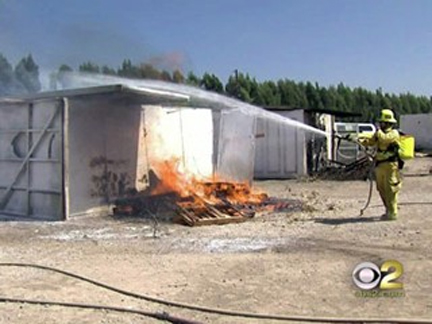
Gel coatings contain water adsorbent polymers (and when activated by water provide an insulating layer). These products can be sprayed on the exterior surfaces of your home prior to evacuating. Once applied, these coatings will lose effectiveness with time as they dry out, so how well it will work when the wildfire reached the building will depend in part on the length of the delay between application (evacuation) and the wildfire exposure.
If firefighters are at your home and know a gel-coating has been applied, they will mist the house with a water spray to rehydrate the gel.
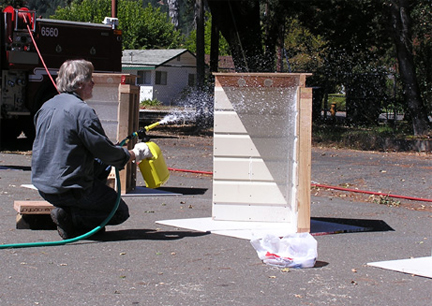
A gel-product is being applied to one of the walls in this corner section. The siding is a nominal 4-inch wide end-and edge glued redwood siding having a rabbeted-bevel lap joint. The gel is being applied by the representative of the gel manufacturer. Half of the siding received the gel coating. A plastic sheet covered the other half during the gel application. For this demonstration, the gel was applied approximately two hours prior to the fire exposure.
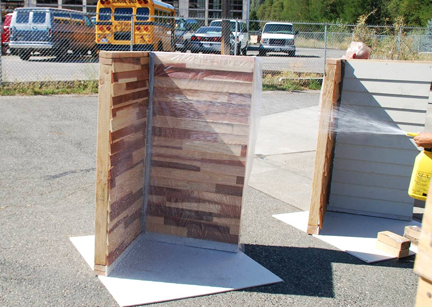
A close up view of the coated wall.
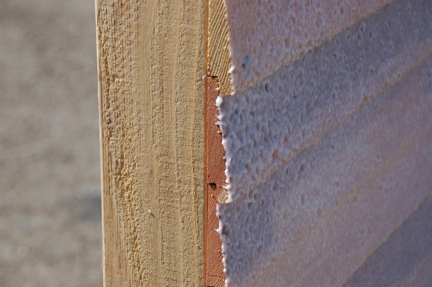
Burning 'B' brands [6-inches by 6-inches] were placed at the base of each wall section, as shown in these photographs. These burning brands provide a flame impingement exposure to the wall (i.e., with fire actually touching the walls). This kind of exposure would be the same as that from burning vegetation, fire wood, or other combustible debris located immediately adjacent to the building.
The heat output of a burning 'B' brand is relatively small, as seen in this photograph. However, it would burn longer than a small to intermediate sized plant.
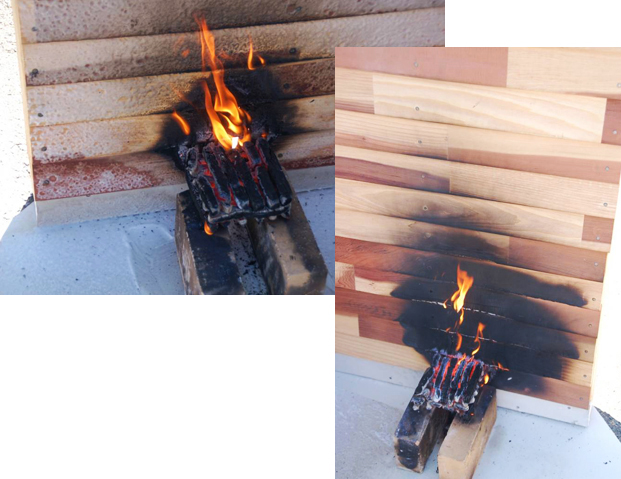
A view of the wall section early in the demonstration. The gel coated wall section is on the left.
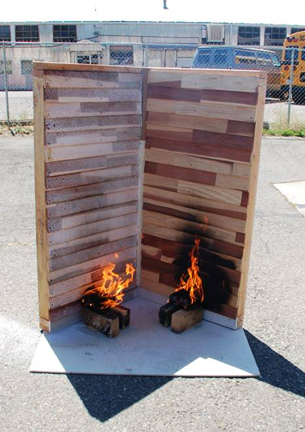
Near the end of the demonstration the fire had burned up the uncoated wall, and was still burning. Flame did not travel far up the gel coated wall. Fire penetrated both the coated and uncoated siding in he vicinity of the 'B' brand. In both cases fire was able to move into the stud cavity.
The results of this demonstration may have been different if the fire exposure had been purely radiant (i.e., vegetation or other burning materials located at a distance from the wall so that flames could not touch the siding).
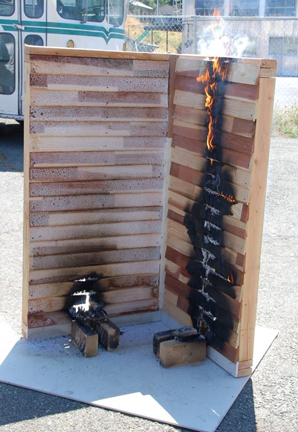
This is a close up view of the over-lap / drip edge area at a lap joint, taken immediately after the gel had been applied. Note that drip edge doesn't have complete coverage. If a flame impingement exposure is possible, application of the gel to the under-lap area needs to be done completely.
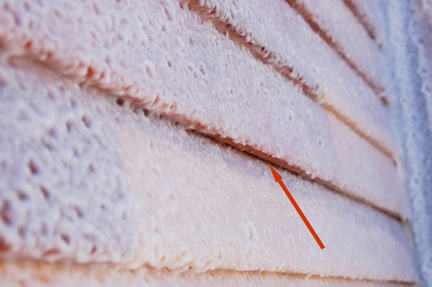
References
DISCLAIMER: Information in this section was compiled as part of the Building in Wildfire Prone Areas project in 2009. This information may or may not be up to date. More recent information may be available from the Insurance Institute for Business and Home Safety, the California Wildland-Urban Interface Code Information, and the CAL FIRE Wildland Hazard/Building Codes site.



